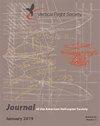未来火星旋翼机非常规叶片结构设计及气动力学分析
IF 1.4
4区 工程技术
Q2 ENGINEERING, AEROSPACE
引用次数: 1
摘要
超薄、非常规翼型转子叶片的结构设计是为了支持NASA推进火星探测转子优化(ROAMX)项目而进行的。外部模具线由NASA提供,内部结构设计由马里兰大学使用基于cad的三维(3D)空气力学分析开发。本文的主要目的是记录由于低雷诺数(低至15K)和高亚音速马赫数(高达0.95)而遇到的独特气动弹性行为。考虑了四种不同的叶片设计,桨距轴从四分之一弦到中弦变化,以确定重心(C.G.)偏移对固有频率、叶片变形、根部载荷和三维应力的影响。每一种设计都强调扭转稳定性——由于火星上的锁数量很低,这一点尤为重要。这些设计首先在真空中进行了研究,通过将节轴移动到更靠近中弦的位置来减少C.G.偏移,可以显著降低根载荷和3D应力。接下来,选择螺距轴为40%弦的设计进行升力线气动力学分析。研究了稳定悬停时叶片控制载荷、气动载荷、变形和三维应力。研究了非定常悬停的动态控制载荷和动态三维应力。有趣的弹性扭转观察到由于空中飞人效应和螺旋桨力矩,反过来影响气动载荷的展向分布。由于惯性耦合,动态控制载荷显著增加。动应力也有所增加,但拉应力和压应力的安全系数均大于2。本文章由计算机程序翻译,如有差异,请以英文原文为准。
Structural Design and Aeromechanical Analysis of Unconventional Blades for Future Mars Rotorcraft
The structural design of rotor blades with ultra-thin, unconventional airfoils is conducted in support of the NASA Rotor Optimization for the Advancement of Mars eXploration (ROAMX) project. The outer mold line was provided by NASA, and the internal structural design was developed at the University of Maryland using a CAD-based three-dimensional (3D) aeromechanical analysis. The main objectives of this paper are to document the unique aeroelastic behavior encountered due to the low Reynolds number (down to 15K) and high subsonic Mach number (up to 0.95). Four different blade designs are considered, with the pitch axis varied from quarter-chord to midchord to determine the effect of center of gravity (C.G.) offset on natural frequencies, blade deformations, root loads, and 3D stresses. Torsional stability is emphasized for each of the designs - especially important due to the low Lock number on Mars. The designs are first studied in vacuum, and significant reductions in root loads and 3D stresses are achieved by moving the pitch axis closer to midchord to reduce the C.G. offset. Next, the design with the pitch axis at 40% chord is selected for a lifting-line aeromechanical analysis. The blade control load, airloads, deformations, and 3D stresses are studied for steady hover. Dynamic control load and dynamic 3D stresses are studied for unsteady hover. Interesting elastic twist is observed due to the trapeze effect and propeller moment, in turn affecting the spanwise distribution of aerodynamic loads. The dynamic control load is found to increase significantly due to inertial coupling from the C.G. offset. The dynamic stresses also increase but still have factors of safety greater than two for both tensile and compressive stress.
求助全文
通过发布文献求助,成功后即可免费获取论文全文。
去求助
来源期刊

Journal of the American Helicopter Society
工程技术-工程:宇航
CiteScore
4.10
自引率
33.30%
发文量
36
审稿时长
>12 weeks
期刊介绍:
The Journal of the American Helicopter Society is a peer-reviewed technical journal published quarterly (January, April, July and October) by AHS — The Vertical Flight Society. It is the world''s only scientific journal dedicated to vertical flight technology and is available in print and online.
The Journal publishes original technical papers dealing with theory and practice of vertical flight. The Journal seeks to foster the exchange of significant new ideas and information about helicopters and V/STOL aircraft. The scope of the Journal covers the full range of research, analysis, design, manufacturing, test, operations, and support. A constantly growing list of specialty areas is included within that scope. These range from the classical specialties like aerodynamic, dynamics and structures to more recent priorities such as acoustics, materials and signature reduction and to operational issues such as design criteria, safety and reliability. (Note: semi- and nontechnical articles of more general interest reporting current events or experiences should be sent to the VFS magazine
 求助内容:
求助内容: 应助结果提醒方式:
应助结果提醒方式:


